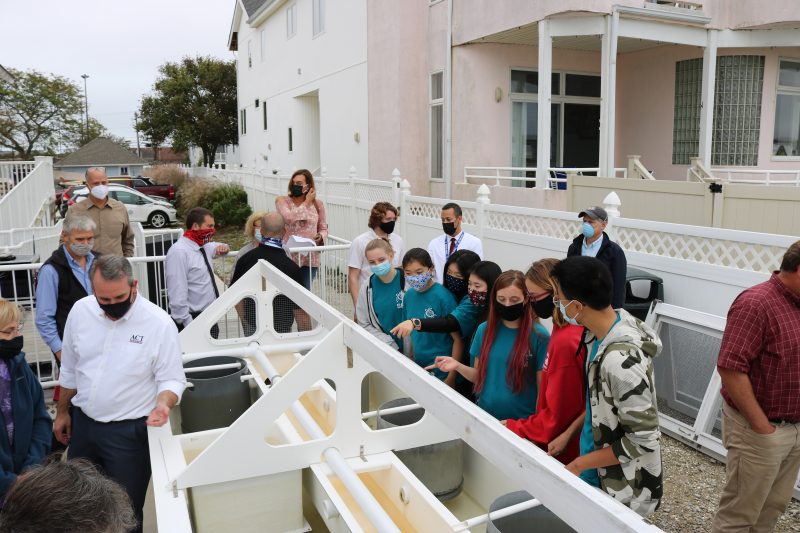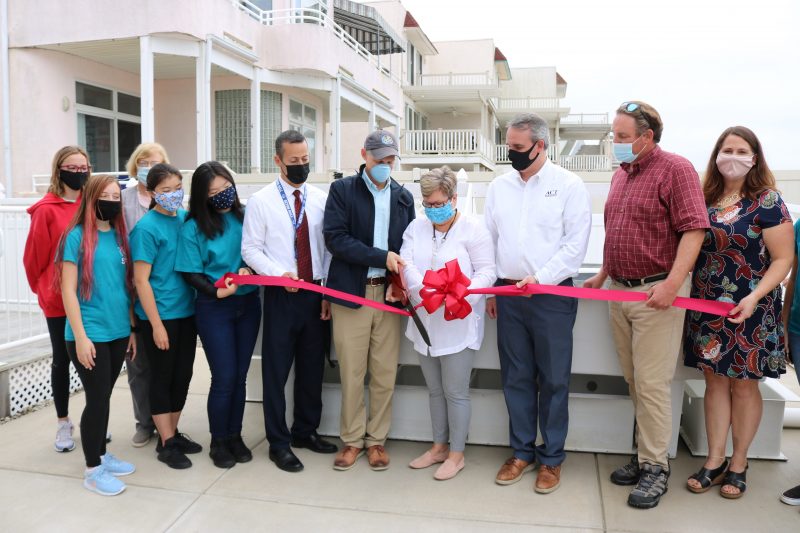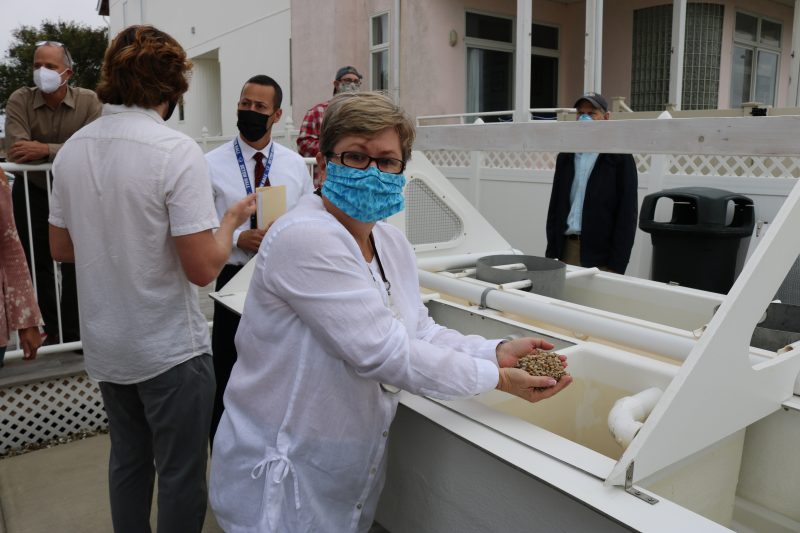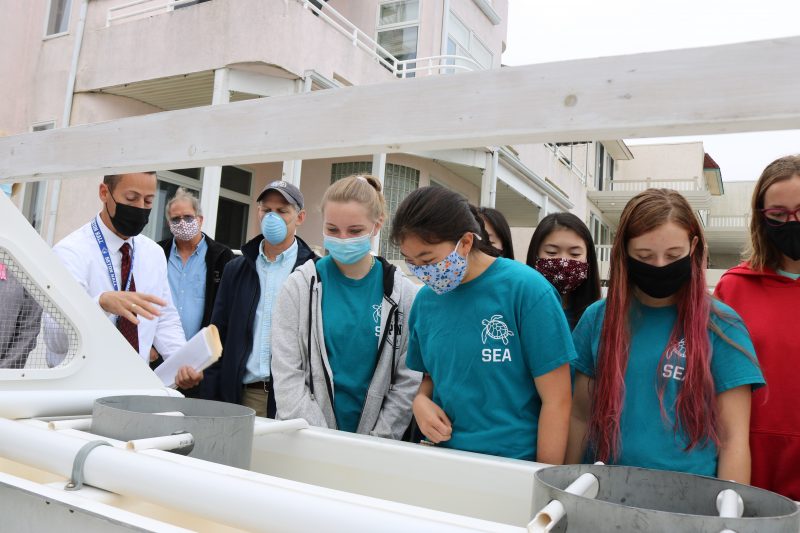Ocean City High School science teacher Keith Zammit is excited about the prospects of using the project as an educational tool.
 By DONALD WITTKOWSKI
Think of clams and what usually comes to mind?
Clams casino? Clam chowder? Linguini with clams, perhaps?
While clams are normally associated with our culinary delights, a much lesser known aspect about these squishy denizens of the bay is the critical role they play in the marine eco-system.
In the science world, clams are known for their uncanny ability to cleanse the bay waters by filtering out potentially harmful microscopic plants and animals, bacteria and viruses. They are also helpful in removing excess nitrogen from the water to prevent toxic algae blooms from forming, experts say.
Hoping to capitalize on the environmental benefits of clams, Ocean City officials gathered at the Bayside Center at 520 Bay Avenue on Friday to celebrate the opening of a shellfish incubator that will prove critical to maintaining a healthy eco-system in the surrounding bay waters.
By DONALD WITTKOWSKI
Think of clams and what usually comes to mind?
Clams casino? Clam chowder? Linguini with clams, perhaps?
While clams are normally associated with our culinary delights, a much lesser known aspect about these squishy denizens of the bay is the critical role they play in the marine eco-system.
In the science world, clams are known for their uncanny ability to cleanse the bay waters by filtering out potentially harmful microscopic plants and animals, bacteria and viruses. They are also helpful in removing excess nitrogen from the water to prevent toxic algae blooms from forming, experts say.
Hoping to capitalize on the environmental benefits of clams, Ocean City officials gathered at the Bayside Center at 520 Bay Avenue on Friday to celebrate the opening of a shellfish incubator that will prove critical to maintaining a healthy eco-system in the surrounding bay waters.
 Michael Allegretto, aide to Mayor Jay Gillian, uses an oversized pair of scissors to cut the ceremonial ribbon for the project.
Michael Allegretto, aide to Mayor Jay Gillian, noted in his remarks at a ceremonial ribbon-cutting that the project is part of Ocean City’s strategy to protect and promote the “three B’s,” the beaches, the Boardwalk and the bay.
Formally known as an “upweller," the shellfish incubator will also be used as a hands-on tool to teach Ocean City High School students about marine life, the shore environment and ways to protect beach communities from coastal storms.
Expressing his excitement, high school science teacher Keith Zammit said both the students and the school district will benefit greatly from the project.
“The opportunities are endless for the school district,” Zammit said.
Michael Allegretto, aide to Mayor Jay Gillian, uses an oversized pair of scissors to cut the ceremonial ribbon for the project.
Michael Allegretto, aide to Mayor Jay Gillian, noted in his remarks at a ceremonial ribbon-cutting that the project is part of Ocean City’s strategy to protect and promote the “three B’s,” the beaches, the Boardwalk and the bay.
Formally known as an “upweller," the shellfish incubator will also be used as a hands-on tool to teach Ocean City High School students about marine life, the shore environment and ways to protect beach communities from coastal storms.
Expressing his excitement, high school science teacher Keith Zammit said both the students and the school district will benefit greatly from the project.
“The opportunities are endless for the school district,” Zammit said.
 Ocean City High School science teacher Keith Zammit is excited about the prospects of using the project as an educational tool.
The upweller consists of a tank system that will pump in bay water to “feed” baby clams their diet of naturally occurring microscopic organisms. Once they are big enough, the clams will be removed from the upweller and placed in the bay to live in their natural environment and help keep the water clean.
“Just one ribbed mussel can filter 15 gallons of water per day, one oyster can filter 50 gallons per day and one clam can filter 24 gallons,” said Junetta Dix, director of environmental services for ACT Engineers, an engineering and environmental consultant for Ocean City.
In addition to helping keep the bay waters clean, the clams will be used to create “habitat castles” that act as a barrier to protect Ocean City from flooding and destructive waves crashing ashore during coastal storms.
Ocean City has already undertaken such a project by creating a 1,700-foot “living shoreline” consisting of shellfish colonies on a neighboring bay islet known as Shooting Island. Shellfish habitats have helped to stabilize the 150-acre Shooting Island’s eroding shoreline and also serve as a storm barrier for Ocean City.
“Our bay islands are speed bumps for wave attenuation and a first line of defense that reduces back bay flooding impacts – but only as long as these islands are still here and not lost to erosion and sea level rise,” Dix explained.
Ocean City High School science teacher Keith Zammit is excited about the prospects of using the project as an educational tool.
The upweller consists of a tank system that will pump in bay water to “feed” baby clams their diet of naturally occurring microscopic organisms. Once they are big enough, the clams will be removed from the upweller and placed in the bay to live in their natural environment and help keep the water clean.
“Just one ribbed mussel can filter 15 gallons of water per day, one oyster can filter 50 gallons per day and one clam can filter 24 gallons,” said Junetta Dix, director of environmental services for ACT Engineers, an engineering and environmental consultant for Ocean City.
In addition to helping keep the bay waters clean, the clams will be used to create “habitat castles” that act as a barrier to protect Ocean City from flooding and destructive waves crashing ashore during coastal storms.
Ocean City has already undertaken such a project by creating a 1,700-foot “living shoreline” consisting of shellfish colonies on a neighboring bay islet known as Shooting Island. Shellfish habitats have helped to stabilize the 150-acre Shooting Island’s eroding shoreline and also serve as a storm barrier for Ocean City.
“Our bay islands are speed bumps for wave attenuation and a first line of defense that reduces back bay flooding impacts – but only as long as these islands are still here and not lost to erosion and sea level rise,” Dix explained.
 Junetta Dix, director of environmental services for ACT Engineers, scoops out some of the baby clams that are being raised.
The upweller project was funded by a $25,000 grant from the New Jersey Corporate Wetlands Restoration Partnership. The restoration partnership is a collaborative group of private corporations, government, non-government agencies and the academic world to preserve and protect natural habitats throughout New Jersey.
“This project meets two important elements of our mission by providing aquatic habitat and improved water quality and educational outreach to the Ocean City High School students and the community,” Russ Furnari, chairman of the restoration partnership, said in a statement about the upweller.
He added, “Our contribution of $25,000 will help assure the successful completion of the project in a way that can serve as a model for future coastal resiliency projects.”
While the incubator is helping to raise thousands of baby clams now, there are plans to also use it to grow ribbed mussels and oysters for coastal restoration projects.
Dix envisions the project becoming a source of shellfish to help other beach communities along the East Coast cleanse their bay water, restore their marshlands and protect their shoreline.
“It’s an amazing project that hopefully will spread along the East Coast,” Dix said in an interview. “The ability of shellfish to filter and clean our coastal waters is phenomenal.”
Junetta Dix, director of environmental services for ACT Engineers, scoops out some of the baby clams that are being raised.
The upweller project was funded by a $25,000 grant from the New Jersey Corporate Wetlands Restoration Partnership. The restoration partnership is a collaborative group of private corporations, government, non-government agencies and the academic world to preserve and protect natural habitats throughout New Jersey.
“This project meets two important elements of our mission by providing aquatic habitat and improved water quality and educational outreach to the Ocean City High School students and the community,” Russ Furnari, chairman of the restoration partnership, said in a statement about the upweller.
He added, “Our contribution of $25,000 will help assure the successful completion of the project in a way that can serve as a model for future coastal resiliency projects.”
While the incubator is helping to raise thousands of baby clams now, there are plans to also use it to grow ribbed mussels and oysters for coastal restoration projects.
Dix envisions the project becoming a source of shellfish to help other beach communities along the East Coast cleanse their bay water, restore their marshlands and protect their shoreline.
“It’s an amazing project that hopefully will spread along the East Coast,” Dix said in an interview. “The ability of shellfish to filter and clean our coastal waters is phenomenal.”
 Ocean City students and others get a closeup look of how the incubator "feeds" the baby clams by pumping in bay water.
Ocean City students and others get a closeup look of how the incubator "feeds" the baby clams by pumping in bay water.